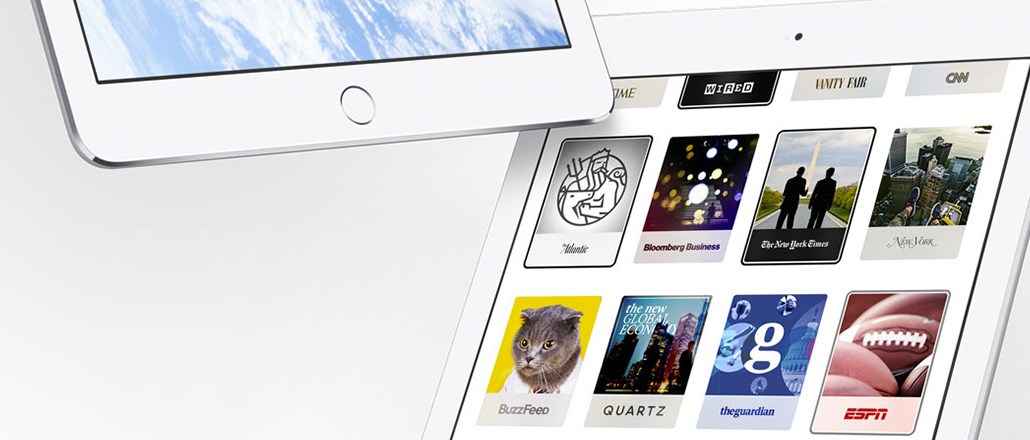
At its Worldwide Developer Conference Monday, Apple announced a new mobile news-reading product, News, with dozens of big media partners including The New York Times, Condé Nast and ESPN. Due out in the fall, News is the latest overture by platforms from Snapchat to Facebook to encourage publishers to distribute their content directly on their apps. Just last month, Facebook launched a similar product, Instant Articles, with nine news publishers including the Times, BuzzFeed and National Geographic.
Here’s how the two compare:
History
Both companies have a fraught history of working with publishers, and their new products seem aimed at improving that relationship. A rundown: Newsstand, Apple’s dedicated home for newspaper and magazine apps, has disappointed. Publishers have complained that it’s hard to get noticed among the 14,000 apps in the Newsstand unless they’re featured by Apple. Even if they’re discovered, it was hard to get people to come back because the app stopped giving users visual cues that a new edition of a publication is available, which was important to driving return visits for publishers.
Facebook’s year-old Paper app, a tool to navigate the news feed, has been slow to gain users. As an increasingly important driver of traffic to publisher sites, Facebook has given publishers reason to be cautious, as it can cut off that traffic with the tweak of an algorithm. Recently, Facebook said it would favor friends’ over publishers’ content, meaning the latter would be less likely to appear in users’ feeds.
Revenue-sharing
In an apparent nod to the importance of premium publisher content to the user experience, both companies will let publishers keep 100 percent of the revenue from advertising they sell themselves within the articles. Both will let publishers keep 70 percent of the revenue if the platform does the selling. Apple’s terms are “favorable, feels like a win-win,” one major publisher said.
Data terms
It’s key to publishers that they retain data on their readers as they disseminate their content on others’ platforms. With Facebook, publishers will have the ability to track data and traffic through comScore and other analytics tools. Apple’s terms seem less favorable. In keeping with its recent focus on privacy, Apple stressed that nothing from the News app is shared with third parties. But an advantage Apple News seems to have over Facebook Instant is that it’s giving publishers the ability to promote subscriptions, newsletters and other direct interactions with readers. Publishers also have high hopes that Apple News will be seamless with their paywalls and subscriptions.
Features
As with its product approach overall, Apple News isn’t as much a revenue play as a desire to serve the reader, so its pitch focused on providing the best user experience possible. Noteworthy was that Apple said News is open to all publishers, whereas Facebook Instant has been a slow roll-out, starting with nine publishers. “One of the challenges of Newsstand is, it’s a little difficult to discover content,” said Michael Silberman, gm of digital media at New York magazine, one of News’ launch partners. “Apple’s intent is to make it easier to find news that’s engaging to you and improve the news-reading and discovery experience in ways that others aren’t necessarily providing as effectively, including currently, Apple.”
Both are offering publishers multimedia tools like galleries and videos to make articles render elegantly (and quickly). “The challenge before was, it takes many layers to reach the content itself,” said Scott McAllister, svp of digital marketing and revenue, Time Inc., also a launch partner. “This is exposing the content immediately.” As with Facebook Instant Articles, Apple suggested publisher branding in News would be strong. But Apple talked more about discovery and curation and stressed personalization in its presentation. News has a feed, “For You,” and the more you read, the more personalized it will become.
Image courtesy of Apple.com
More in Media

WTF is behind the explosion of faceless creators?
Brands are rapidly increasing their spending on faceless creators, showing the unique benefits of working with this type of influencer.

In Graphic Detail: As ‘Grow a Garden’ booms, a new report shows the marketing power of Roblox
The explosive growth of “Grow a Garden” has brought new attention to Roblox — and rejuvenated marketers’ interest in its advertising power.

Brand deals surge for golf creators as the sport’s popularity spikes
Golf is booming, and so is influencer marketing. As a result, golf creators are signing an unprecedented number of brand deals in 2025.





